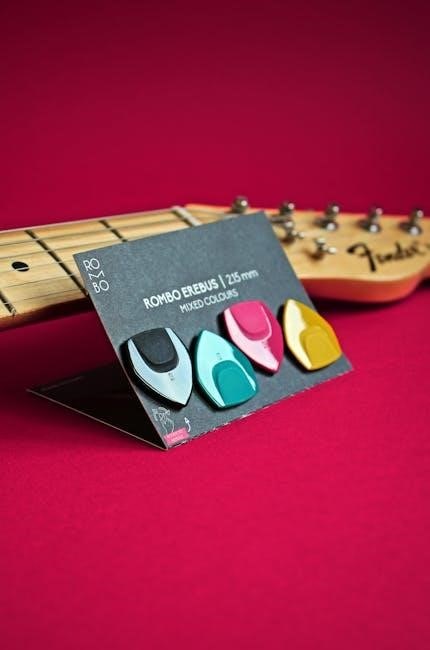fender mustang 1 manual

This comprehensive guide is designed to help you master the Fender Mustang 1 amplifier‚ exploring its features‚ customization options‚ and troubleshooting tips for optimal performance.
Overview of the Fender Mustang 1 Amplifier
The Fender Mustang 1 is a versatile‚ compact practice amplifier designed for guitarists of all skill levels. It combines high-quality digital modeling with a user-friendly interface‚ offering a wide range of tones and effects. With 24 presets‚ 8″ speaker‚ and USB connectivity‚ it’s ideal for home practice‚ recording‚ and small performances. The amp features built-in effects like delay‚ reverb‚ and modulation‚ allowing for customization to suit various playing styles. Its compact size and lightweight design make it portable‚ while the Fender Fuse software enables deep customization and preset management. Whether you’re a beginner or an experienced player‚ the Mustang 1 delivers flexibility and quality‚ making it a popular choice for modern guitarists.
Importance of the Manual for Optimal Use
The Fender Mustang 1 manual is essential for unlocking the amp’s full potential. It provides detailed guidance on navigating the control panel‚ understanding preset customization‚ and troubleshooting common issues. By following the manual‚ users can optimize their tone‚ explore advanced features like Fender Fuse software‚ and maintain the amplifier’s performance over time. The manual also ensures safe operation‚ helping users avoid potential damage from incorrect settings or connections. Whether you’re a beginner or an experienced guitarist‚ the manual serves as a valuable resource for mastering the Mustang 1’s capabilities and achieving the best possible sound for your playing style.
Key Features of the Fender Mustang 1
The Fender Mustang 1 is a versatile amplifier designed for modern guitarists‚ offering 24-bit digital signal processing and 24 customizable presets. It features a range of amp models‚ from classic Fender tones to high-gain contemporary sounds‚ allowing for diverse musical styles. The amp includes built-in effects such as delay‚ reverb‚ and modulation‚ providing a rich sonic palette. The Fender Fuse software enables deep customization of presets and effects‚ while the intuitive control panel makes it easy to navigate and adjust settings. With its compact design and robust features‚ the Mustang 1 is ideal for practice‚ recording‚ and live performance‚ catering to both beginners and experienced players seeking versatility and high-quality tone.

Getting Started with the Fender Mustang 1
Getting started with the Fender Mustang 1 is an exciting experience. Begin by unpacking and plugging in your guitar. Explore the intuitive controls‚ amp models‚ and effects to find your perfect tone. This section guides you through the initial setup and basic operation‚ helping you unlock the amp’s full potential.
Unboxing and Initial Setup
Unboxing the Fender Mustang 1 reveals a sleek‚ compact amplifier designed for versatility. Inside‚ you’ll find the amp‚ a power cord‚ a USB cable‚ and a quick start guide. Fender ensures the packaging is secure to protect the equipment during shipping. For initial setup‚ place the amp on a flat‚ stable surface in a well-ventilated area. Plug in the power cord and connect your guitar using a standard 1/4-inch cable. Download and install the Fender Fuse software to access additional features and presets. Register your amp on Fender’s website for warranty and updates. Familiarize yourself with the controls and start exploring tones—begin with a factory preset to get a feel for the amp’s capabilities. Ensure the amp is placed in a dry environment to maintain optimal performance.

Connecting Your Guitar and Other Devices
To connect your guitar‚ use the 1/4-inch input on the front panel. Plug in your instrument cable securely to ensure a clear signal. For external audio sources like phones or CDs‚ use the auxiliary input for jamming along with tracks. Headphones can be connected via the dedicated headphone jack‚ allowing silent practice. The USB port enables connection to a computer for using the Fender Fuse software. A MIDI controller can also be linked for advanced preset switching during performances. Always use the correct cable types to avoid damage or interference. Proper connections ensure optimal sound quality and functionality‚ enhancing your overall playing experience with the Mustang 1.
Navigating the Control Panel
The Fender Mustang 1’s control panel is user-friendly‚ with a clear layout designed for easy navigation. The LCD screen displays preset information‚ while the encoder knob allows you to scroll through presets and adjust settings. Preset buttons let you save and recall your favorite tones instantly. The Gain‚ Volume‚ and EQ controls are straightforward‚ enabling precise tone shaping. The effects section includes knobs for Delay‚ Reverb‚ and other modulation effects‚ making it simple to tweak your sound. The control panel’s intuitive design ensures quick access to all features‚ allowing you to focus on playing without confusion. This streamlined interface makes it easy to explore and customize your sound‚ enhancing your overall musical experience.
Fender Fuse Software: A Comprehensive Guide
Fender Fuse software enhances your Mustang 1 experience‚ offering preset customization‚ firmware updates‚ and seamless tone tailoring. It’s a powerful tool for personalizing your sound effortlessly.
Installing and Updating Fender Fuse

Installing Fender Fuse software is straightforward. Download the latest version from Fender’s official website‚ ensuring compatibility with your operating system. Run the installer and follow on-screen instructions. Once installed‚ connect your Mustang 1 amp via USB to sync the software. Regular updates are essential for new features and bug fixes. To update‚ open Fender Fuse‚ navigate to the settings menu‚ and check for updates. If an update is available‚ download and install it‚ then restart the software. Always ensure your amp is connected during updates to maintain compatibility. Troubleshooting tips‚ like reinstalling the software or checking USB connections‚ can resolve common issues. Keeping Fender Fuse updated ensures optimal performance and access to the latest features.

Navigating the Fender Fuse Interface
The Fender Fuse interface is user-friendly‚ designed to simplify amp customization. Upon opening‚ you’ll see a preset browser on the left‚ allowing quick access to factory and custom presets. The main window displays real-time amp controls‚ including gain‚ EQ‚ and effects. A tuner is also accessible for quick adjustments. On the right‚ the amp model and effects sections let you tweak tones and add pedals virtually. Use the control panel to adjust settings like reverb and delay. Save your customizations by clicking the “Save Preset” button. The software also includes a “Settings” tab for USB connectivity and firmware updates. Navigating Fender Fuse is intuitive‚ making it easy to dial in your perfect sound and save it for future use.
Customizing Presets with Fender Fuse
Customizing presets with Fender Fuse is a seamless process that allows you to tailor your sound to your preferences. Start by selecting a base preset from the library or choosing an empty slot to create from scratch. Adjust amp models‚ EQ settings‚ and effects to shape your tone. Use the intuitive controls to tweak parameters like gain‚ bass‚ mid‚ and treble for precise tonal adjustments. Add or modify effects such as delay‚ reverb‚ and distortion to enhance your sound further. Once satisfied‚ save your custom preset for easy access during performances or practice. This feature ensures your Fender Mustang 1 is fully personalized‚ making it versatile for any musical style or playing situation. Experiment freely to unlock endless tonal possibilities and create a sound that’s uniquely yours.
Troubleshooting Common Software Issues
Encountering software issues with Fender Fuse? Start by ensuring your Fender Mustang 1 is properly connected to your computer via USB. If the software doesn’t recognize the amp‚ restart both devices and check the USB connection. Outdated drivers or firmware can also cause problems‚ so verify that all components are up to date. If presets fail to load‚ try reinstalling the Fender Fuse software or resetting your amp to factory settings. Additionally‚ check for conflicts with other audio programs running in the background. For persistent issues‚ consult the Fender support website or forums for detailed troubleshooting guides tailored to your specific problem.

Understanding the Presets and Effects
The Fender Mustang 1 offers a wide range of built-in presets and effects‚ allowing you to achieve diverse tones and sounds with ease. These features enable customization‚ enhancing your musical creativity and performance.
Exploring Factory Presets
The Fender Mustang 1 comes equipped with a variety of factory presets designed to deliver exceptional tone and versatility. These presets cater to different genres and playing styles‚ from clean‚ crisp tones to heavily overdriven sounds. Guitarists can easily navigate through the presets using the amp’s control panel or the Fender Fuse software. Each preset is crafted to showcase the amp’s capabilities‚ offering a solid foundation for further customization. Whether you’re playing rock‚ blues‚ or metal‚ the factory presets provide a great starting point for achieving your desired sound. Experimenting with these presets is a fantastic way to explore the amp’s potential and discover new sonic possibilities.
Creating and Saving Custom Presets
Customizing your sound with the Fender Mustang 1 is made easy by creating and saving your own presets. Start by dialing in your desired tone using the amp’s EQ‚ gain‚ and effects controls. Once you’ve achieved the perfect sound‚ press and hold the save button on the control panel to store your preset. You can also use the Fender Fuse software to fine-tune and organize your presets with greater precision. Naming and saving your custom tones allows quick access during performances or practice sessions. This feature ensures your unique sounds are always ready to use‚ making the Mustang 1 a versatile tool for musicians seeking personalized tones;
Using Effects: Delay‚ Reverb‚ and More
The Fender Mustang 1 offers a wide range of built-in effects‚ including delay‚ reverb‚ chorus‚ and tremolo‚ to enhance your sound. To access these effects‚ navigate to the effects section on the control panel and select the desired option using the corresponding buttons. Adjust the effect parameters‚ such as delay time or reverb level‚ to tailor the sound to your preference. The amp’s intuitive interface allows for seamless switching between effects during practice or performance. Experimenting with different effect combinations can add depth and versatility to your playing style. Whether you’re creating lush ambient tones or sharp‚ rhythmic delays‚ the Mustang 1’s effects palette provides endless creative possibilities for guitarists of all genres.
User Experiences and Reviews
Guitarists praise the Fender Mustang 1 for its ease of use and versatile tones. Many appreciate its portability and value. Some note minor software quirks but overall satisfaction remains high.
Positive Feedback from Guitarists
The Fender Mustang 1 has received widespread acclaim for its versatility and ease of use. Guitarists appreciate its compact design‚ lightweight build‚ and robust feature set‚ making it ideal for practice and small gigs. Many musicians praise the wide range of tones available‚ from clean to high-gain‚ and the intuitive controls that allow for quick adjustments. The built-in effects‚ such as delay and reverb‚ are particularly well-liked for their high quality and ease of customization. Additionally‚ the Fender Fuse software is often highlighted as a major advantage‚ enabling users to tweak and save presets with precision. Overall‚ the Mustang 1 is celebrated for its value‚ portability‚ and ability to deliver great tones in various musical settings;
Common Criticisms and Workarounds
Some guitarists have noted that the Fender Mustang 1’s preset storage is limited to 24 locations‚ which can be restrictive for those who rely heavily on multiple custom tones. To address this‚ users suggest organizing presets strategically and using Fender Fuse to manage and swap tones easily. Another critique is the amp’s menu navigation‚ which can feel a bit cumbersome for beginners. A workaround is to familiarize yourself with the manual and use the Fender Fuse software for easier editing. Additionally‚ some players find the control panel’s small buttons and lack of labels challenging. Using a label maker or relying on muscle memory can help streamline the process.
Real-World Applications and Versatility
The Fender Mustang 1 is highly versatile‚ making it suitable for a variety of musical settings. Its compact size and lightweight design make it ideal for home practice‚ small gigs‚ and even recording sessions. Guitarists across genres‚ from rock to blues and jazz‚ appreciate its ability to deliver clean tones‚ crunchy overdrives‚ and rich‚ effects-driven sounds. The amp’s USB connectivity allows for direct recording to a computer‚ while its auxiliary input is perfect for jamming along with tracks. Whether you’re a beginner or a seasoned player‚ the Mustang 1 adapts to your needs‚ offering a balance of simplicity and advanced features. Its portability and diverse tone options make it a reliable choice for both practice and performance.

Tips for Getting the Best Tone
Experiment with EQ settings‚ leverage the gain structure‚ and adjust volume levels to tailor your sound. Understanding the amp’s versatility and digital effects enhances tone customization for any style.
Adjusting EQ Settings for Different Styles
To achieve the best tone for various music styles‚ tailor your Fender Mustang 1’s EQ settings accordingly. For rock‚ emphasize mids and highs for clarity and punch. Jazz benefits from a balanced EQ with a slight low-end boost for warmth. Blues requires midrange warmth and moderate highs‚ while country often demands bright highs for twang. Metal needs heavy low-end emphasis and mid-scoop. Clean tones may prefer a flatter EQ‚ and lead tones could use high-mid boosts for presence. Experiment by boosting or cutting frequencies in bass (80-200 Hz)‚ mids (200-2000 Hz)‚ and treble (above 2000 Hz). Make small adjustments‚ listen carefully‚ and reference tracks to match desired sounds effectively.
Using the Gain and Volume Controls Effectively
The Fender Mustang 1’s Gain and Volume controls are essential for shaping your tone. The Gain control adjusts the preamp stage‚ determining the level of distortion or overdrive. Lower gain settings produce clean tones‚ while higher settings deliver gritty‚ overdriven sounds. The Volume (Master Volume) control regulates the overall loudness after the preamp stage. For clean tones‚ keep the Gain low and Volume moderate. For overdriven sounds‚ increase the Gain and adjust the Volume to balance loudness and distortion. Experiment with both controls to find the perfect blend for your style. Balancing Gain and Volume ensures optimal tone without sacrificing clarity or dynamics. This interaction is key to achieving your desired sound.
Optimizing the Amp for Different Guitars
The Fender Mustang 1 is versatile and can be tailored to suit various guitars. For single-coil pickups‚ reduce the high-frequency EQ to minimize brightness‚ while humbuckers may benefit from a slight high-end cut to avoid muddiness. guitars with active pickups often require lower gain settings to prevent over-saturation. Tonewoods like alder or ash may need a mid-boost for clarity‚ whereas mahogany guitars might require a slight bass reduction. Experiment with the amp’s EQ settings to complement your guitar’s natural tone. Adjust the presence control to fine-tune high-end response. For brighter guitars‚ lower the presence; for darker ones‚ raise it. This ensures a balanced sound regardless of your guitar’s specifications.
Maintenance and Troubleshooting

Regularly clean the amp and check for loose connections. Troubleshoot issues like no sound by ensuring power is on and cables are secure. Consult the manual for specific solutions or contact Fender support for persistent problems.
Cleaning and Caring for Your Amp
Regular cleaning is essential to maintain the Fender Mustang 1’s performance and appearance. Use a soft‚ dry cloth to wipe the exterior‚ avoiding harsh chemicals or polishes. For dust buildup‚ gently use a soft-bristle brush or compressed air on a low setting‚ ensuring no moisture enters the vents or grille. The grille can be cleaned with a slightly damp cloth‚ but avoid soaking it. Avoid placing the amp in direct sunlight or humid environments‚ as this can damage the finish or internal components. Store the amp upright or use a quality cover when not in use to protect it from dust and spills. Proper care ensures longevity and optimal sound quality.
Diagnosing and Fixing Common Issues
If your Fender Mustang 1 isn’t functioning properly‚ start by checking the power supply and ensuring all cables are securely connected. Common issues include no sound‚ distorted audio‚ or software connectivity problems. For no sound‚ verify the volume levels and ensure the amp is switched on. If distortion occurs‚ reduce the gain or check for loose guitar cables. For Fender Fuse software issues‚ restart both the amp and computer‚ then reinstall the software if necessary. If problems persist‚ consult the manual or contact Fender support. Regularly updating firmware and drivers can also resolve many issues. Always use authorized Fender parts for repairs to maintain performance and warranty validity.
Updating Firmware and Software
Regular updates are essential to ensure your Fender Mustang 1 performs optimally. To update the firmware‚ connect the amp to your computer via USB and open Fender Fuse software. Check for updates under the “Help” or “Settings” menu; Follow the on-screen instructions to download and install the latest version; Ensure the amp remains connected throughout the process to prevent interruptions. Software updates often include bug fixes‚ new features‚ or improved compatibility. Always use the official Fender website or Fender Fuse for updates to avoid unauthorized modifications. After updating‚ restart the amp to apply changes. Keep your system up-to-date for the best experience.

Resources for Further Learning
Explore official Fender manuals‚ online forums‚ and video tutorials for in-depth guides and troubleshooting tips to enhance your Fender Mustang 1 experience and knowledge.
Official Fender Manuals and Guides
The official Fender Mustang 1 manual is a comprehensive resource that provides detailed instructions for setup‚ operation‚ and troubleshooting. Available on Fender’s website or through their support page‚ this guide covers everything from basic controls to advanced features like Fender Fuse software integration. It includes diagrams‚ specifications‚ and step-by-step instructions to help users get the most out of their amplifier. The manual also offers tips for optimizing tone and maintaining the amp. For users seeking in-depth technical information or specific guidance‚ Fender’s official documentation is an invaluable tool. Regularly updated‚ these resources ensure users stay informed about the latest features and firmware updates.
Online Communities and Forums
Online communities and forums dedicated to the Fender Mustang 1 are invaluable for connecting with fellow musicians and troubleshooting issues. Platforms like Fender’s official forums‚ Reddit‚ and Facebook groups provide spaces to share experiences‚ ask questions‚ and learn from experienced users. These communities often feature detailed discussions about amp settings‚ custom presets‚ and creative uses for the Mustang 1. Many users also share tips for optimizing tone and resolving common problems. Additionally‚ these forums are great for discovering new techniques and staying updated on the latest trends in guitar playing and amp usage. Engaging with these communities can enhance your overall experience with the Fender Mustang 1.
Video Tutorials and Reviews
Video tutorials and reviews are excellent resources for mastering the Fender Mustang 1. Platforms like YouTube and Fender’s official channel offer in-depth guides‚ covering everything from basic setup to advanced tone customization. Many professional reviewers and seasoned musicians share detailed walkthroughs of the amp’s features‚ such as preset navigation‚ effect customization‚ and firmware updates. These videos provide visual demonstrations‚ making complex tasks easier to understand. Additionally‚ gear comparison videos help users appreciate the Mustang 1’s unique capabilities. Watching these tutorials can inspire new playing techniques and help users achieve their desired sound. They also serve as a great supplement to the manual‚ offering real-world examples and practical advice.

The Fender Mustang 1 manual provides a comprehensive guide to unlocking the amp’s full potential‚ ensuring a seamless and enjoyable playing experience for guitarists of all levels.
By following the manual and exploring its features‚ users can fully harness the Mustang 1’s versatility and creativity‚ making it an indispensable tool for musical expression and growth.
Final Thoughts on the Fender Mustang 1
The Fender Mustang 1 is a powerful‚ versatile amplifier designed to meet the needs of guitarists at all skill levels. Its compact size‚ rich tones‚ and advanced features make it an excellent choice for both practice and performance. The inclusion of customizable presets and effects ensures endless creativity. With the guidance of the manual‚ users can fully explore its capabilities‚ from classic tones to modern‚ experimental sounds. Whether you’re a beginner or a seasoned player‚ the Mustang 1 offers a seamless and enjoyable experience. Its combination of traditional Fender quality and cutting-edge technology makes it a standout in its class‚ providing unparalleled value for musicians seeking a reliable and inspiring amplifier.
Encouragement to Explore and Experiment
Don’t hesitate to dive deep into the Fender Mustang 1’s features and experiment with its vast possibilities. The amp’s versatility and user-friendly interface make it an ideal platform for creativity. Try tweaking presets‚ layering effects‚ and exploring different EQ settings to craft unique tones. Whether you’re a novice or an advanced player‚ the Mustang 1 encourages exploration and helps you develop your personal sound. Experimenting with the Fender Fuse software and customizing presets can open up new sonic horizons. Push the boundaries‚ test the limits‚ and let the Mustang 1 inspire you to create something truly original and unforgettable.